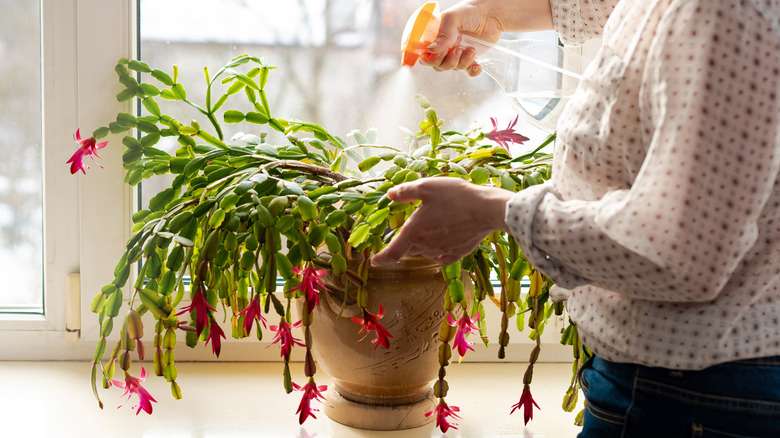Garden
Erica Crawford
As you shop for holiday decorations and gifts for your loved ones, you might stumble upon a colorful Christmas cactus (Schlumbergera x buckleyi) on the retail floor. This is a widely loved plant when the Thanksgiving and Christmas seasons roll around because, while most plants go dormant as cold weather approaches, this one blooms brightly in the early to mid-winter months.
Unlike other cacti, you’ll find that your Christmas cactus does not like dry or hot temperatures. Heritage Land Bank explains that this plant is native to tropical rainforests in Brazil and prefers higher humidity, frequent watering, and indirect sunlight. When grown in the right conditions, the cactus will thrive and blossom annually, and live for decades. Its blossoms are vibrant, from reds and pinks to yellows and oranges, and even white and purple. A Christmas cactus is a gorgeous additions to the home, but it can be tricky to coerce flowers out of them, as they require precise lighting and care for a successful seasonal bloom.
Encouraging your Christmas cactus to bloom

TSViPhoto/Shutterstock
Even though these cacti have different watering and lighting needs than most, they still do well in similar soil to that of other succulents. Add peat moss and perlite to the potting mix to increase its draining capabilities, and water once every two to three weeks when the top portion of the soil has completely dried. Chicago Botanic Garden notes that humidity is essential to the health of a cactus. Keeping the plant in a bright area of the home with higher humidity, such as a kitchen or bathroom with a window, will be beneficial.
In order to produce flowers, the cactus must experience 13 to 15 hours of complete darkness each day. Artificial light from indoor lamps needs to be kept from your cactus during these dark hours. If you have to move the cactus to different parts of the home or cover it so it meets these lighting needs, it won’t harm the plant. The cactus prefers cooler temperatures at night but can sit at 70 degrees Fahrenheit or above if given the longer end of required time in the shade. The Christmas cactus should be repotted infrequently, only once every year or two if it shows signs of needing more room. When provided with the best conditions, you can expect to have a blooming cactus for four to six weeks, with each flower lasting six to nine days before falling off and sprouting a new one.
Christmas or Thanksgiving cactus
Morgenstjerne/Getty Images
A common issue many find when it comes to their Christmas cactus is that it’s not actually the true Christmas variety. Retailers will typically bring out their winter selections around the beginning of November when the very similar Thanksgiving cactus is in full bloom. One of these might be labeled as a Christmas cactus because it’s more appealing to bring home plants in full bloom, but at this point it’s already well into its yearly flowering. By December, the flowers will be gone, and you’ll be left wondering what you did wrong.
If you want blossoms on your cactus come Christmas, you must ensure you have not brought home a Thanksgiving variety by mistake. These two cacti are relatively easy to tell apart when you understand the difference between them. The evidence lies in the shape of the leaves, reports Garden Gate. A Thanksgiving cactus holds leaves with toothed or claw-like projections from their edges. These sharper features will differ from the scalloped, teardrop appearance of the Christmas cactus leaves.
Whether you have a Christmas or Thanksgiving cactus, these plants are delightful additions to the home and perfect for gift giving. Unlike other holiday plants such as holly, mistletoe, and poinsettias, these cacti are not toxic if ingested by children or pets, making them a beautiful plant and a safe one too.
